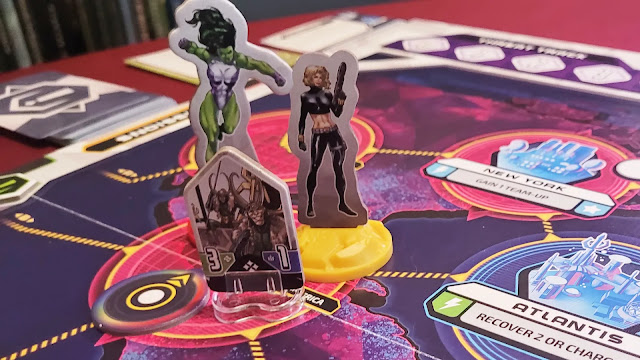Portions of the text for this review originally appeared in my Savage Core Expedition Journal project blog at OnTableTop.com.
As is often the case with skirmish games, the thing that initially drew me to Savage Core was the miniatures. I was shopping for wild west figures and stumbled into what might have happened if Jules Verne and Edgar Rice Burroughs had worked together to design a line of miniatures. The Savage Core is an underground primeval jungle populated by superintelligent apes, lost Atlanteans, ice age cavemen, dinosaurs, and more.
The game looked interesting too, so I wasted no time in placing an order. In fact, I got so distracted by thoughts of pulp adventure that I completely forgot to order the cowboys I went there for in the first place...
A game of Savage Core is a head-to-head battle, with around seven figures per side. A player's force revolves entirely around their faction’s Boss, an individual character who has six game stats and a unique set of “tricks,” special abilities that can each be used once per game and are themed to that character. Your other six models (in a normal game) are “Bods,” nameless minions whose stats might vary slightly between one faction and the next but who don’t have any particular abilities of their own.
A game round starts with each player rolling for initiative to determine who will go first. Each player then gets a chance to play one of their tricks, which can be anything from devastating area attacks to causing an opposing figure to get lost in the jungle, only to reappear on a later turn.
The first player moves all their models, then the second player moves, then the first player makes all their attacks, then the second player. Going first isn't an advantage, as the second player will have the opportunity to move out of range before you get a chance to make any attacks. The only thing that can possibly help with this is the fact that movement distance for each figure is random, with each model rolling a d10 and adding their Clip (movement) value. So if you move into position for a great ranged attack, you can at least hope that they don't roll high enough to get away. It might sound fun in theory but in practice it can be pretty aggravating.
Combat in Savage Core is resolved first by an opposed roll using the relevant stat (Moxie for ranged or Buff for close combat) plus a d10 roll to see if the target is hit. After all hits have been determined, the targets roll for each successful hit to see if they’re wounded. Bods die after one wound, but Bosses can take four or five before they go down. Damage is resolved at the end of the round, so if one of your characters gets eliminated they’ll still get a chance to attack before they go.
By far the most interesting thing about Savage Core is Double Trouble. On any round that both players roll the same number for initiative, it triggers a random encounter taken from a list that can include anything from a wave of lava creeping across the board to a ravenous T-Rex stomping out of the bushes and eating any models it comes into contact with. Double Trouble is what got me interested in the Savage Core rules set in the first place, and it is easily the most fun and interesting thing about the game.
These encounters add a lot of flavor and enjoyable chaos, but they don’t happen nearly often enough in an average game. We were lucky to get one on our first turn, but in our previous match we didn’t get one until the last round, when it was too late for it to have any appreciable effect. And it’s certainly possible to go a whole game without having one at all. There is a scenario in the rule book called “Rumble in the Jungle” that has a Double Trouble encounter happening every single turn, but that seems like a bit too much.
I do like how simple the game is -- there's not a lot you have to remember, with only one named character on each side, and the six once-per-game abilities still provide a fair amount of flavor and variation between the different characters. It’s not like Shatterpoint, where you really have to stay on top of the synergies between characters, or Knight Models’ Batman, where each character has so many complicated special abilities that it’s impossible to keep track of it all.
On the other hand, the game can (and does) swing wildly based on the egregious amount of die rolling. Successful hits only result in damage half the time (even less for ranged attacks), which can be frustrating. Additionally, most of the the more powerful and interesting trick cards require a seemingly arbitrary die roll in order to work, and there is generally no way to mitigate these rolls. And don’t get me started on rolling for movement...
It might just need an attitude adjustment to make peace with the randomness of it all and enjoy Savage Core for what it is. But this is still a miniatures wargame that require a hefty level of preparation in the form of assembling and painting models and terrain -- the game play needs to be substantial enough to justify all that work.
Rating: 3 (out of 5) There are a few great concepts here, and the setting and miniatures are magnificent, but the core mechanics revolve around completely arbitrary die rolls a little too much.
- Savage Core official website
- Savage Core Facebook group



















